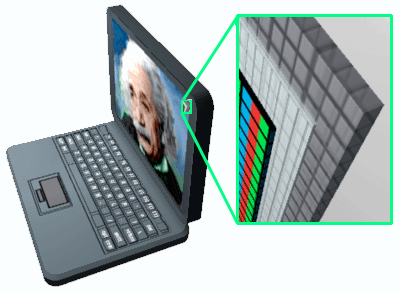Laptop Screens
 There are a few new physics principles that govern how a laptop works. You
might want to learn or review polarization before you read this
section.
There are a few new physics principles that govern how a laptop works. You
might want to learn or review polarization before you read this
section.
|
 Is anything I learned about television the same for laptop screens?
Is anything I learned about television the same for laptop screens?
 All the color perception stuff is the same. That is, the picture that you
see on your laptop screen is again made up of many red, green and blue dots.
All the color perception stuff is the same. That is, the picture that you
see on your laptop screen is again made up of many red, green and blue dots.

 So the back of my laptop screen is coated with phosphors too!
So the back of my laptop screen is coated with phosphors too!
 No, this is where things become different. On a laptop screen each "dot" is
actually a tiny device rather than a phosphor.
No, this is where things become different. On a laptop screen each "dot" is
actually a tiny device rather than a phosphor.

One "pixel" is made up of 3 "cells".
 What do you mean by a "tiny device"?
What do you mean by a "tiny device"?
 Let's call it a "cell." You can think of the laptop screen as made up of a lot
of tiny cells. White light coming from behind the screen passes through each
cell and emerges toward you as you watch the screen. At the end of the cell
the light goes through a red, green or blue filter, so the cell takes on that
color. A "trio" of red, green and blue cells taken together is a pixel. The
color of each pixel is determined by how bright its three cells are.
Let's call it a "cell." You can think of the laptop screen as made up of a lot
of tiny cells. White light coming from behind the screen passes through each
cell and emerges toward you as you watch the screen. At the end of the cell
the light goes through a red, green or blue filter, so the cell takes on that
color. A "trio" of red, green and blue cells taken together is a pixel. The
color of each pixel is determined by how bright its three cells are.
 So each cell is like a phosphor. But how is the brightness of a cell
controlled? In a TV the brightness was controlled by an electron beam hitting
phosphors. I'll bet in a laptop it has something to do with liquid crystals!
So each cell is like a phosphor. But how is the brightness of a cell
controlled? In a TV the brightness was controlled by an electron beam hitting
phosphors. I'll bet in a laptop it has something to do with liquid crystals!
 Absolutely! But before we discuss liquid crystals we need to recall some facts
about polarization. Do you remember what happens when unpolarized light first
goes through a vertical polarizing lens and then through a horizontal
polarizing lens?
Absolutely! But before we discuss liquid crystals we need to recall some facts
about polarization. Do you remember what happens when unpolarized light first
goes through a vertical polarizing lens and then through a horizontal
polarizing lens?
 Yeah, it gets completely blocked. But we could use some intermediate
polarizing lenses to "twist" the light so that some got through.
Yeah, it gets completely blocked. But we could use some intermediate
polarizing lenses to "twist" the light so that some got through.
 That's right. In a similar way, a liquid crystal device can rotate the
polarization of the light, so that it gets through the second polarizer. But
when we apply an electric signal, the liquid crystal no longer rotates the
light, and then it gets blocked. In this experiment,
when the current is "on" the device glows yellow.
That's right. In a similar way, a liquid crystal device can rotate the
polarization of the light, so that it gets through the second polarizer. But
when we apply an electric signal, the liquid crystal no longer rotates the
light, and then it gets blocked. In this experiment,
when the current is "on" the device glows yellow.
 Wait a second... we turn the signal on and the cell goes dark? That's
confusing. I have so many questions! First, how does that liquid crystal
device work?
Wait a second... we turn the signal on and the cell goes dark? That's
confusing. I have so many questions! First, how does that liquid crystal
device work?





